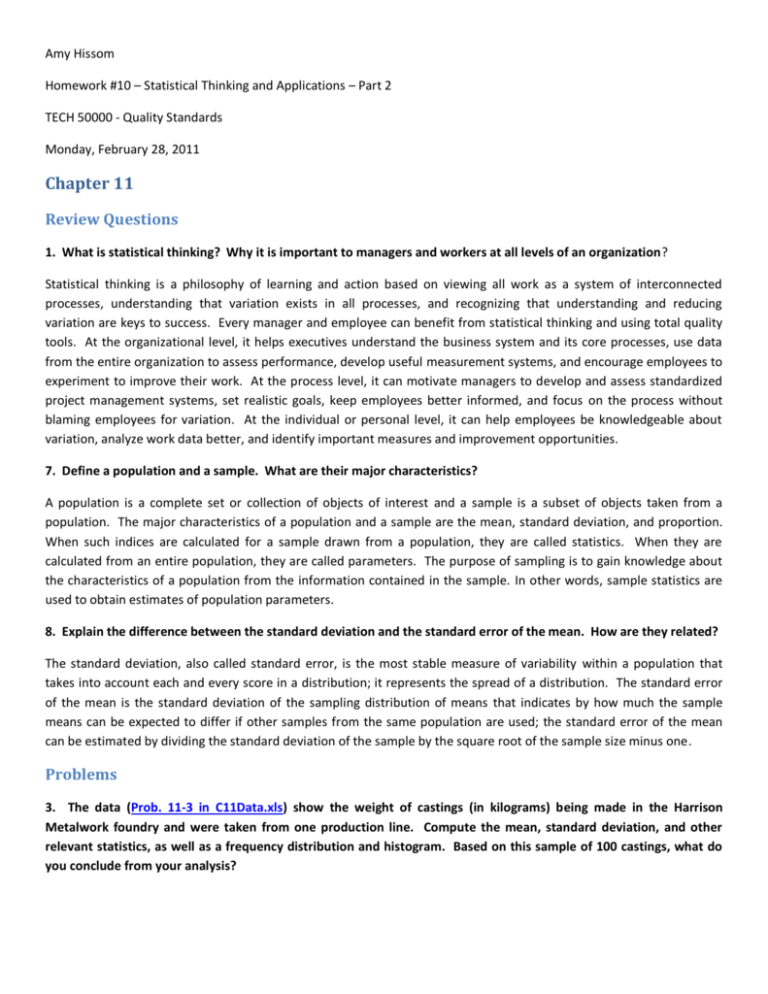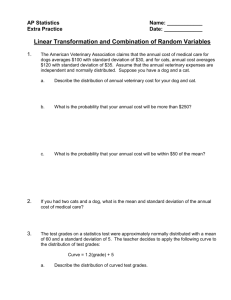Statistical Thinking and applications - Amy E. Hissom
advertisement

Amy Hissom Homework #10 – Statistical Thinking and Applications – Part 2 TECH 50000 - Quality Standards Monday, February 28, 2011 Chapter 11 Review Questions 1. What is statistical thinking? Why it is important to managers and workers at all levels of an organization? Statistical thinking is a philosophy of learning and action based on viewing all work as a system of interconnected processes, understanding that variation exists in all processes, and recognizing that understanding and reducing variation are keys to success. Every manager and employee can benefit from statistical thinking and using total quality tools. At the organizational level, it helps executives understand the business system and its core processes, use data from the entire organization to assess performance, develop useful measurement systems, and encourage employees to experiment to improve their work. At the process level, it can motivate managers to develop and assess standardized project management systems, set realistic goals, keep employees better informed, and focus on the process without blaming employees for variation. At the individual or personal level, it can help employees be knowledgeable about variation, analyze work data better, and identify important measures and improvement opportunities. 7. Define a population and a sample. What are their major characteristics? A population is a complete set or collection of objects of interest and a sample is a subset of objects taken from a population. The major characteristics of a population and a sample are the mean, standard deviation, and proportion. When such indices are calculated for a sample drawn from a population, they are called statistics. When they are calculated from an entire population, they are called parameters. The purpose of sampling is to gain knowledge about the characteristics of a population from the information contained in the sample. In other words, sample statistics are used to obtain estimates of population parameters. 8. Explain the difference between the standard deviation and the standard error of the mean. How are they related? The standard deviation, also called standard error, is the most stable measure of variability within a population that takes into account each and every score in a distribution; it represents the spread of a distribution. The standard error of the mean is the standard deviation of the sampling distribution of means that indicates by how much the sample means can be expected to differ if other samples from the same population are used; the standard error of the mean can be estimated by dividing the standard deviation of the sample by the square root of the sample size minus one. Problems 3. The data (Prob. 11-3 in C11Data.xls) show the weight of castings (in kilograms) being made in the Harrison Metalwork foundry and were taken from one production line. Compute the mean, standard deviation, and other relevant statistics, as well as a frequency distribution and histogram. Based on this sample of 100 castings, what do you conclude from your analysis? Descriptive Statistics Harrison Metalwork Foundry Production Line 1 Frequency Distribution Weight of Castings (kilograms) Based on a Sample of 100 23 25 23 6 3 39.9 39.6 39.3 39 38.7 38.4 1 38.1 1 Frequenci… 10 8 37.8 30 25 20 15 10 5 0 37.5 38.6700 0.0456 38.7000 38.4000 0.4556 0.2076 0.3747 -0.1715 2.6000 37.3000 39.9000 3867.0000 100.0000 0.0904 Frequency Mean Standard Error Median Mode Standard Deviation Sample Variance Kurtosis Skewness Range Minimum Maximum Sum Count Confidence Level (95.0%) Boundaries The descriptive statistics and histogram that I computed from the raw data in Prob. 11-3 in C11Data.xls using Excel’s analysis tools is shown below. Based on the sample of 100 castings obtained from Harrison Metalwork Foundry’s production line, I would say that although there is a minor skewing to the right, the distribution of the data seems to be fairly normal. 7. Outback Beer bottles have been found to have a standard deviation of 5 ml. If 95 percent of the bottles contain more than 230 ml, what is the average filling volume of the bottles? If, σ = 5 ml. x = 230, and P (z>x) =0.95 Since, 0.5000-0.9500=0.45, then based on the z-chart, z = -1.6455. So, if 1.6455 x 5 = 8.2275 And Then µ = 238.2275 Therefore, µ = 238.228 ml. is the average filling volume of the bottles. This is where I am a little confused on rounding the number. Is µ actually 238.228 or is it 238.223? 11. In a filling line at A & C Foods, Ltd., the mean fill volume for rice bubbles is 475 grams and the standard deviation is 10 grams. What percentage of containers will have less than 450 grams More than 485 grams (assuming no overflow)? If, µ = 475 grams and σ = 10 grams, then to show the percentage of containers having less than 450 grams: P(x<450) = 0.5000 – P (450< x <475) So, using the z-chart: P (z<450) = 0.5000- 0.4798=0.0202 Therefore, 2.02% of the containers will have less than 450 grams. If, µ = 475 grams and σ = 10 grams, then to show the percentage of containers having more than 485 grams: P(x>485) = 0.5000 – P (475< x <485) So, using the z-chart: P (z>485) = 0.5000- 0.3413= 0.1587 Therefore, 15.87% of the containers will have more than 485 grams. 12. The frequency table that follows shows the weight of castings (in kilograms) being made at the Harrison Metalwork foundry after process changes took place (see Prob. 11-3, in C11Data.xls, for “raw” data). Frequency Table Upper Cell Frequencies Boundaries 37.5 1 37.8 3 38.1 8 38.4 23 38.7 25 39.0 23 39.3 10 39.6 6 39.9 1 Cell Cell 1 Cell 2 Cell 3 Cell 4 Cell 5 Cell 6 Cell 7 Cell 8 Cell 9 Cell Adjusted Cell Midpoints 37.35 37.65 37.95 38.25 38.55 38.85 39.15 39.45 39.75 Cell 1 Cell 2 Cell 3 Cell 4 Cell 5 Cell 6 Cell 7 Cell 8 Cell 9 Frequencies 1 3 8 23 25 23 10 6 1 Cumulative % 1.00% 4.00% 12.00% 35.00% 60.00% 83.00% 93.00% 99.00% 100.00% fx 37.35 112.95 303.60 879.75 963.75 893.55 391.50 236.70 39.75 fx^2 1395.02 4252.57 11521.62 33650.44 37152.56 34714.42 15327.23 9337.82 1580.06 3858.90 148931.73 a) Based on this sample of 100 castings, find the mean and standard deviation of the sample. (Note: If only the given data are used, it will be necessary to research formulae for calculating the mean and standard deviations using grouped data from a statistics text.) ̅ ∑ √∑ ∑ √ √ Source: www.drweedman.com/Mean.doc Based on the adjusted midpoints the mean is 38.589 and the standard deviation is 0.4566 opposed to the descriptive statistics on the Excel spreadsheet for problems #3 that shows the mean as 38.670 and the standard deviation as 0.4556. Again I am confused on rounding. Is the answer 0.4566 or is it 0.457? b) Use an Excel spreadsheet, if not already done for problem 11-3, to plot the histogram for the data. Please see problem #3 above and attached Excel file. c) Plot the data on normal probability paper to determine whether the distribution of the data is approximately normal. (Note: The Regression tool in Excel has a normal probability plot that may be used here.) Y Looking at the following plot chart, I would say the distribution of the data is approximately normal. 40.5 40.0 39.5 39.0 38.5 38.0 37.5 37.0 0.0000 Normal Probability Plot 20.0000 40.0000 60.0000 80.0000 100.0000 Sample Percentile 15. Determine the approximate sample size to estimate the proportion of sorting errors at a post office at a 99 percent confidence level. Historically, the sorting error rate is 0.0125, and you wish to have an allowable statistical error of 0.01. (Note: Problems 15-19 address sample size determination and refer to theory covered in the Bonus Material for this chapter as contained on the student CD-ROM.) CI = 99% z /2 = 2.58 (Since the value of “Z” based on the z-chart should be 2.58 for 99% confidence)(0.995) p = 0.0125 1-p = 1 – 0.0125 = 0.9875 E = 0.01 So, n = (z a/2)2 p (1-p) / E2 n = (2.58)2 (0.0125) (0.9875) / (0.01)2 n = 821.649375 n = 821.65 n = 822 as the approximate sample size.









